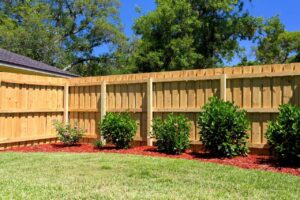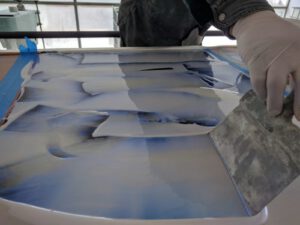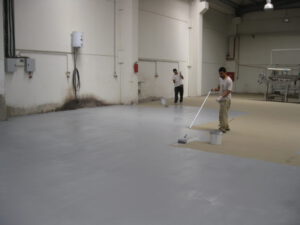Wooden Fence NJ can provide many benefits for your property. They can reduce noise, increase privacy, and protect livestock and pets. They come in different styles and materials, including wood lattice and louver fencing.

The most important part of any wooden fence is its posts. They need to be properly installed and evenly spaced. They should be anchored in concrete to prevent rot.
Wooden Fences are a great way to keep your property private and help you mark your property boundaries. They require regular maintenance to remain safe, but they can last for decades with proper care. It is also important to choose the right type of wood, as different types of wood will be better suited for different climates. For example, some varieties of cedar are naturally resistant to rot and insects, while others are more susceptible.
The cost of a wooden fence is determined by several factors, including the type of wood used and the size of the structure. The most common type of wooden fence is made of treated pine, which is the most economical option. However, there are other more expensive options, such as redwood and cedar. These options may be more durable, but they will cost significantly more than treated pine.
To determine the cost of a wood fence, start by measuring the length and height of your desired fence. Once you have the measurements, multiply them by the price per lineal foot to get the total cost. You can also visit a local wood merchant and ask for advice on the best type of wood to use. Remember that the type of wood you choose will impact how long the fence will last and how much it will weigh.
If you want to preserve the natural beauty of your wooden fence, consider using a stain that will prevent the sun’s rays from bleaching it. This will not only make your fence look more attractive, but it will also protect the wood from rot. Stains are also available in a wide range of colors, so you can find one that matches your home or landscaping.
You can also reduce the risk of damage to your wood fence by trimming vegetation that grows too close to it. This will help to prevent the roots or branches from damaging the wood or causing rot. It is recommended to trim any vegetation every 6-8 months, and it is a good idea to do this before the first frost of the season.
Durability
The durability of Wooden Fence is determined by a number of factors. The first is the type of wood used. Some types of lumber are vulnerable to insect damage, while others are resistant. The type of climate where your home is located is also important. If your area gets a lot of rain, choose a durable wood that is resistant to warping and mildew growth. This will prevent the wood from becoming saturated, which can lead to rot and mold.
The type of stain you use on your fence is also a big factor in its longevity. Staining protects the wood from insects and rotting, and it helps preserve its color and natural beauty. It is a good idea to stain your fence regularly, preferably every two or three years.
If you are unsure about which type of stain to use, consult a professional. You can also find a guide to staining your fence on the internet. You should also purchase a few gallons of stain at the same time, as it is a good idea to have some extra on hand in case you run out. It is also a good idea to make sure you buy the right type of stain for your specific climate.
Another way to increase the durability of your wooden fence is to treat it with a protective sealant within a year of installation. This will help shield the wood from the sun’s powerful ultraviolet rays and will increase its lifespan by as much as triple.
A wood fence requires a considerable amount of maintenance to stay in good condition. One of the best things you can do is to regularly inspect it for signs of termite infestation and to use a pest control service as necessary. Termite damage can be very expensive and can shorten the lifespan of a wood fence dramatically.
A wood fence is an investment that can add value to your home and increase your property’s curb appeal. However, it is important to remember that your investment is only as good as the quality of the materials and the workmanship used to build it. If you are not familiar with building a wood fence, it is best to hire a professional to do the work for you. Inexperienced homeowners can easily ruin their new fence by making poor choices in the materials and construction techniques.
Appearance
The appearance of wood fences can be improved with staining, sealing and painting. This will help preserve the natural beauty of the fence and protect it from water and UV rays. When choosing a stain for your fence, look for one that is semitransparent and contains UV inhibitors and mildewcide. These ingredients will slow the graying of the wood and prevent it from developing mold and mildew. A good quality stain will also provide a level of protection against insects.
Wood fencing comes in many different styles. Some are solid panels, while others are made from rails and boards. In these types of wooden fences, the boards are spaced in a uniform manner to manage light and privacy. Another style is a shadow box fence, which has gaps between the boards to make it more transparent. Regardless of the type of fence you choose, it is important to choose a color and stain that complements your home.
A wood fence is an attractive and durable way to define a property. It can also be used to contain livestock, control access to a pool, or keep pets in and out of certain areas. Wood fences can be made from a variety of materials, including cedar and pressure-treated wood. The most common wood for fences is pine, which has a natural appeal and is inexpensive. Pine is not as durable as some other varieties of wood, however, and it can be damaged by moisture.
While a wooden fence can add a lot of curb appeal to your home, it can also be difficult to maintain. It is important to clean and stain your fence regularly to ensure that it looks great. A wood fence should be sanded before staining and should be allowed to dry before applying the stain. When applying the stain, use a brush or roller for maximum coverage. If you want to stain the fence again in the future, it is best to wait a year after the initial application.
A wood fence is a great way to enhance the look of your house and increase its value. In addition to its practical uses, it can also serve as a visual barrier that provides security and privacy for your property. However, like any other investment, your wood fence will need to be maintained. To protect your investment, it is essential to stain and seal your fence.
Maintenance
Wooden fences have different life spans depending on the type of wood used. Cedar has the longest lifespan, followed by spruce and pine. Regular maintenance and proper care can prolong the lifespan of any wooden fence. Typical maintenance includes painting, staining and removing debris. Keeping the fence free from moisture and fungi can also extend its lifespan. A good sealer will provide a protective barrier against moisture. It is best to re-stain every couple years.
Staining a fence protects the wood from water, fungi and UV rays. The stain also provides color and beauty. Using a natural-looking semitransparent stain allows the grain and texture of the wood to show through. The stain should contain ultraviolet inhibitors and mildewcide to help the wood resist rot and fungal growth. You can get stain samples at your local home improvement store to determine which color is best for your yard.
If the wood appears gray or worn, consider reviving it with a power washer and a bleach solution. This is a cheap and easy way to improve the appearance of your wooden fence.
Proper vegetation control is another important element of maintenance. Overgrown plants can exert pressure on the fence and lead to structural damage over time. In addition, they can attract pests and create a fire hazard. To maintain a healthy wood fence, trim any bushes or vines that are in contact with the fence and regularly remove debris from around the base of the structure.
A common sign that a wooden fence needs repair is a broken board. This is not only unsightly, but it can compromise the integrity of the entire structure. Loose boards and sagging sections are also signs that the fence is deteriorating. Leaving these issues unattended can result in more costly repairs.
Generally, a well-maintained wooden fence lasts about 30 years. To keep your fence looking its best, you should perform regular inspections to check for loose boards and deteriorating hardware. If you notice any problems, make sure to address them immediately.

